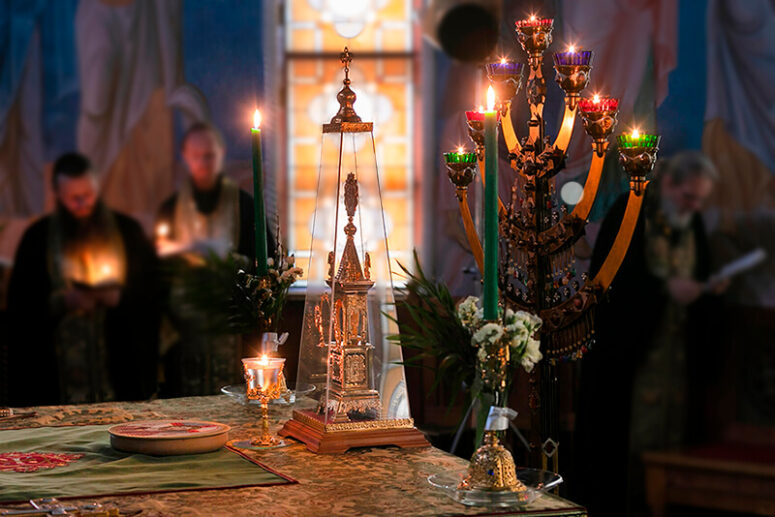
A tabernacle is a sacred vessel for keeping the Holy Gifts — the Body and Blood of Christ. The Holy Gifts are prepared on Holy Thursday and used for the entire year. They are used for communing the sick and dying outside the church. The tabernacle is always located on the altar. It is also called a monstrance, ark, zion, or sepulchre.
History of the Tabernacle
Small reliquaries for keeping the Holy gifts have been known since the first half of the third century. During the Divine Liturgy, members of the early Christian church placed into holy vessels particles of the Body of Christ dipped into His Blood, so that they could receive Holy Communion at home for themselves or their kin.
The first tabernacle in the full sense of the word was perhaps the Eucharistic Dove. Saint Basil the Great, a fourth-century saint, suspended a metal figure of a dove above the altar, as a symbol of the Holy Spirit. During the blessing of the Holy Gifts, the Dove would flutter its wings. In later years, eucharistic doves began to be used at other churches. They were hollow and had an opening for the Holy Gifts.

Eventually, small rectangular reliquary boxes succeeded the doves. With time, it became the practice to embellish them and use a variety of shapes – churches, censers, belfries, the Ark of the Covenant, scenes from the Sacred History, etc.
Why is a tabernacle a sanctuary within a church?
There are two basic reasons. Ostensibly, reliquaries are very common, especially in the form of a kivot. But more deeply, a reliquary is a vessel for the most sacred relics, the Body and Blood of Christ, and thus approaches in significance the temple of Christ itself, and fully deserves this name.

How is a tabernacle different from a repository of the Holy Gifts?
The tabernacle always remains on the altar, and it must be placed in a different vessel to take it elsewhere. We refer to it as the repository.
A repository is commonly a small metal box in the form of a temple, with an image of the cross on its front. Inside a repository is another vessel where a particle of His Body is placed, along with a communion cup and spoon. A reliquary is kept in a bag of expensive cloth or leather. In keeping with the old pious tradition, a priest will often carry it on his breast.

Materials and adornment
According to the Sluzhebnik, the materials of choice for all liturgical vessels are gold or silver. Tin metal is allowable in exceptional circumstances. In contemporary practice, brass is also common. The main criterion for the choice of material is its ability to resist forming oxides.
In the Russian Orthodox Church, arks mostly come in the form of a sepulchre with a high canopy (also called ciborium). Reliquaries shaped as temples or Noah’s ark are also widespread. There are no strict rules, and churches and even regions may use a variety of forms.

Liturgical practice
The Sluzhebnik establishes rules on the use of the Ark. The clergy must keep it closed at all times and make sure that the Holy Gifts are always in it. They must always place the Ark on the altar. It is a mortal sin meriting penance if anyone but the clergy touches it.
Exceptions are allowed only in extraordinary cases. For example, in a fire or any other event that threatens the destruction of a church, the priest must first take to safety the holy vessel and the antimins. But if unable to do it himself, he is allowed to ask for the help of a layperson.
Where the reliquary is not golden, or the gifts cannot be laid on a gold surface, a clean piece of paper must be put under them.
A priest must inspect the condition of the Holy gifts every three days. He must wear nothing on his head and have his hands clean during the inspection. Allowing the Gifts to be infested with mould or spoiled with moisture is a grave sin that merits expulsion from the priesthood.




